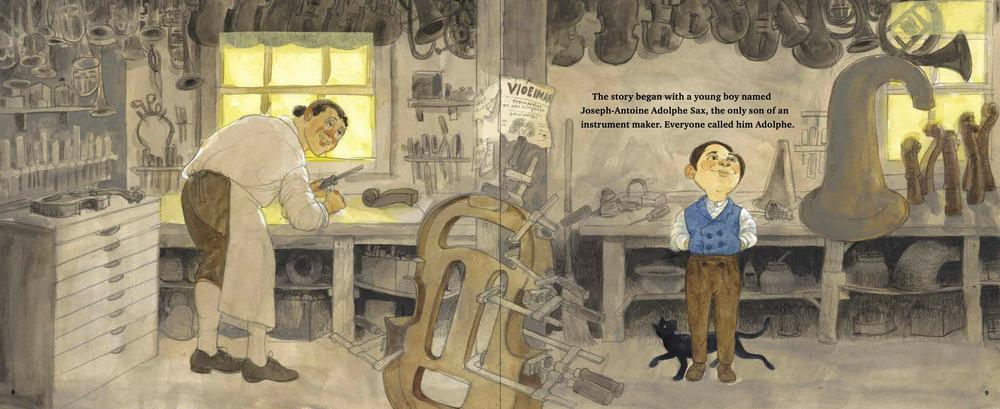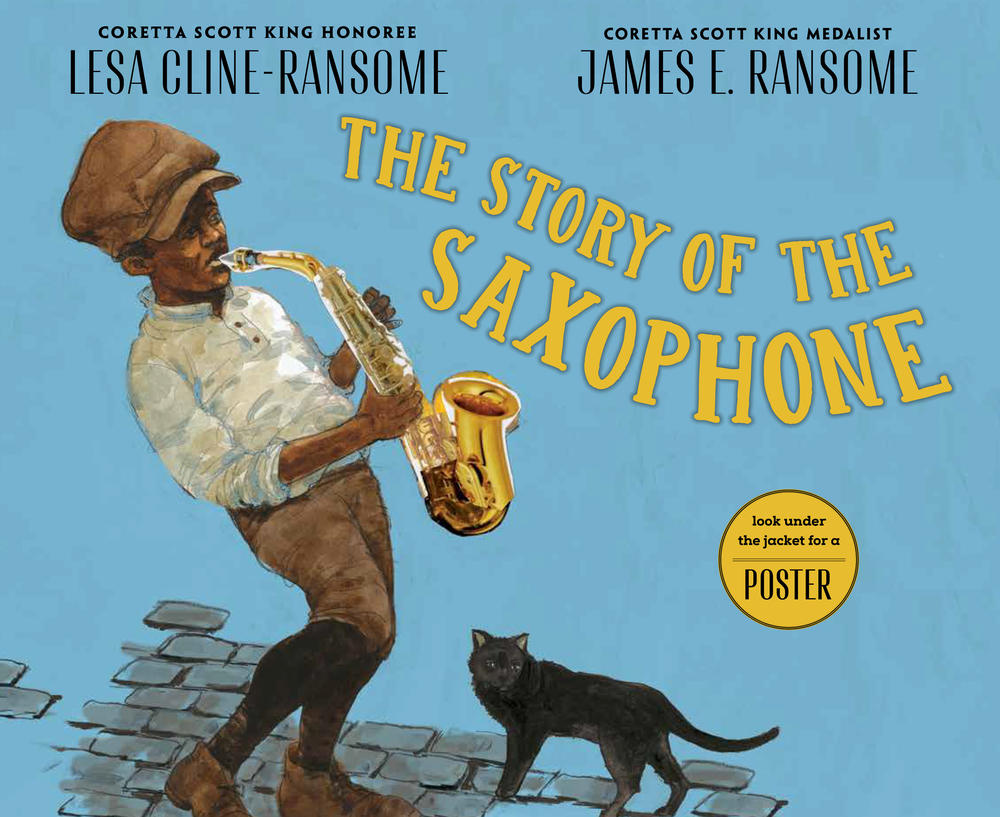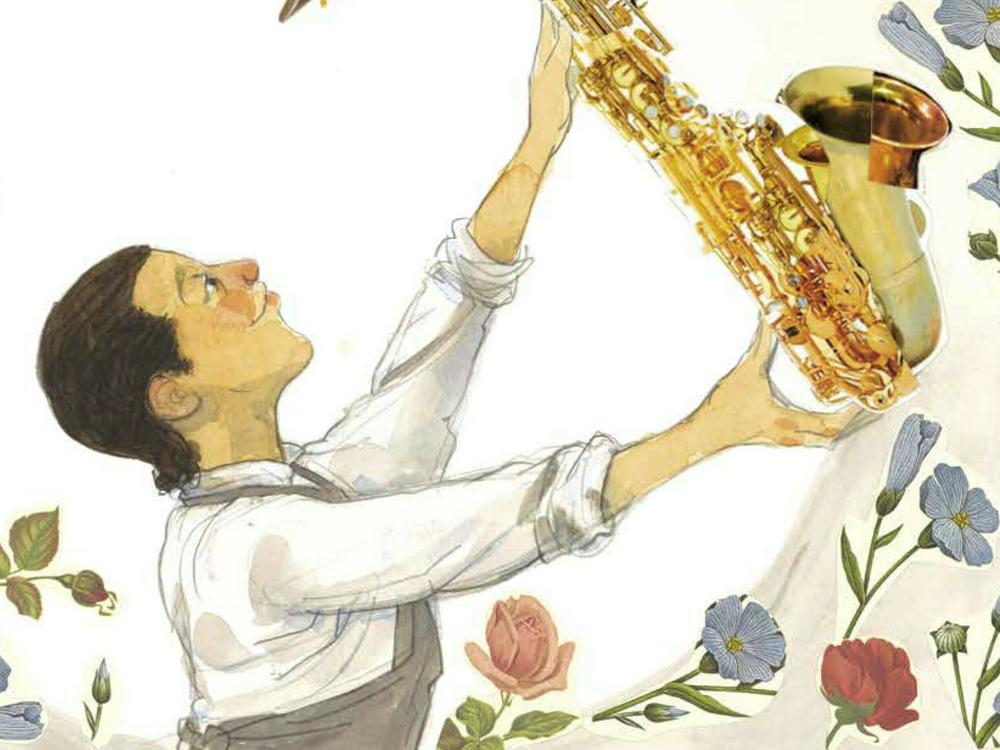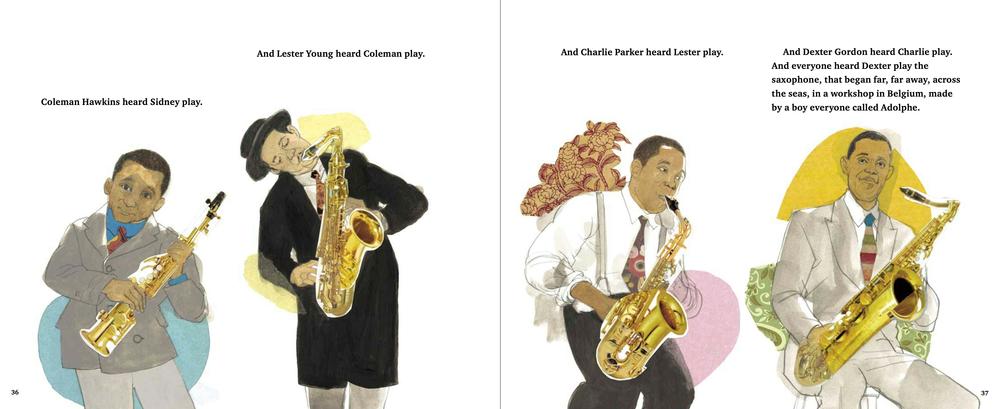Section Branding
Header Content
Trumpet was too loud, clarinet was too soft — here's 'The Story of the Saxophone'
Primary Content
Lesa Cline-Ransome and James Ransome met at a "Purple Rain" party when they were 19 — sophomores at Pratt Institute.
"I asked her to dance, and we've been dancing together ever since," says James Ransome.
Cline-Ransome was in the fashion department. Ransome was an illustration student. They began dating.
"I think we knew we were a match because he would help me with all of my art projects and I would help him with all of his writing assignments," says Cline-Ransome. "And that's kind of how we knew we would be together forever."
They've now been married for 33 years. During that time, Lesa Cline-Ransome became an author and James Ransome, an illustrator. Together, they've now created multiple picture books including Before She Was Harriet, Overground Railroad, and Satchel Paige.
The Story of the Saxophone is their latest children's book, inspired by a mutual love of jazz. The couple had just finished watching Jazz, the 2001 PBS documentary, and James Ransome had an idea. He knew that saxophonists like Coleman Hawkins and Lester Young were instrumental in helping the saxophone gain popularity in the jazz world.
"So I said, 'This would be great to do a book about Coleman Hawkins and Lester Young, sort of a comparison about their sounds.'"
Cline-Ransome was interested, and started doing some research. "When I'm working on a book, I really need to be connected to the subject," she says. And this time she wasn't quite feeling it.
She decided to switch gears.
"One day I just asked myself this really simple question: Who invented the saxophone? And I found an incredible story."
Antoine-Joseph "Adolphe" Sax lived in Dinant, Belgium in the 1800s. And he was often bored.
"So he daydreamed, especially when he should have been paying attention," Cline-Ransome writes in the book. "By the time he was 10, he had fallen down a flight of stairs, swallowed a needle, been poisoned three times, nearly drowned, been burned by gunpowder, and been knocked into a coma from a loose roof tile."
Adolphe also happened to be the son of an instrument maker. And he was very, very curious. As he tinkered in his father's workshop, he ended up inventing several instruments: the steam organ, the sax tuba, the euphonium, the bass tuba, and the flugelhorn.
"But Adolphe was daydreaming of a new sound," Cline-Ransome writes. "Not as loud as a trumpet. Not as soft as a clarinet. Somewhere right in the middle."
Finally, he landed on his masterpiece: the saxophone.
"People often called it the Devil's Horn," says Cline-Ransome. "It was just too, you know, human-like and seductive and sexy."
It was a hard sell at first, but Adolphe got the saxophone into every regimental band in Paris, then Prussia, Italy, Spain, and Hungary followed.
This was the story Cline-Ransome wanted to write: the story of how this Belgian instrument eventually ended up making its way to the Americas, where it was transformed by jazz musicians. It was even better than what James Ransome had expected. "I sort of pitch an idea and then she goes and knocks a home run," he explains.
For the art, Ransome created black and white drawings with touches of watercolor. The colors are subtle, and the characters are slightly humorous, with big eyes and ruddy cheeks.
All of the saxophones in the book, of which there many, are collages — cut-outs of magazine pictures and photos of saxophones.
"I really wanted them to stand out," says Ransome. "I wanted it to be that sort of dominant thing on the page that we sort of follow this like a bouncing ball going through the book."
Cline-Ransome says that's one reason why her husband is one of her favorite illustrators. "Using collage for the saxophone ... it replicates the idea of this boy who pieced together this brand new instrument," she explains. "And so it really does illustrate that."
Even though Ransome came up with the original idea for the story, and even though they live in the same house, the married couple says they don't work together while the book is being created. After the initial story generation, it can be as long as a year before Ransome starts illustrating the book.
"Lesa does not come in and comment on the pictures or say anything about them," says Ransome.
"I'm incredibly impatient," adds Cline-Ransome. "I'm always, 'Where is this? Where's the book? How long does it take?'"
Though she does love being surprised by the final images: "He creates worlds for young readers that I think are just magical."
No spoilers, but the rest of Adolphe's life was full of twists and turns, ups and downs. He died in 1894, but his saxophone lives on, as Cline-Ransome writes, "On street corners and in juke joints, at funerals and in jazz clubs."
If readers learn one thing from the story of Adolphe Sax, Cline-Ransome says she hopes it is that they should always remain curious.
"Sometimes the ways in which we live and grow in this world ... curiosity sometimes is the first thing that leaves us," she says. "I think that sometimes kids in particular aren't encouraged to ask and explore enough. And it was only through Antoine-Joseph "Adolphe" Sax's curiosity that he made these discoveries."
Copyright 2023 NPR. To see more, visit https://www.npr.org.




